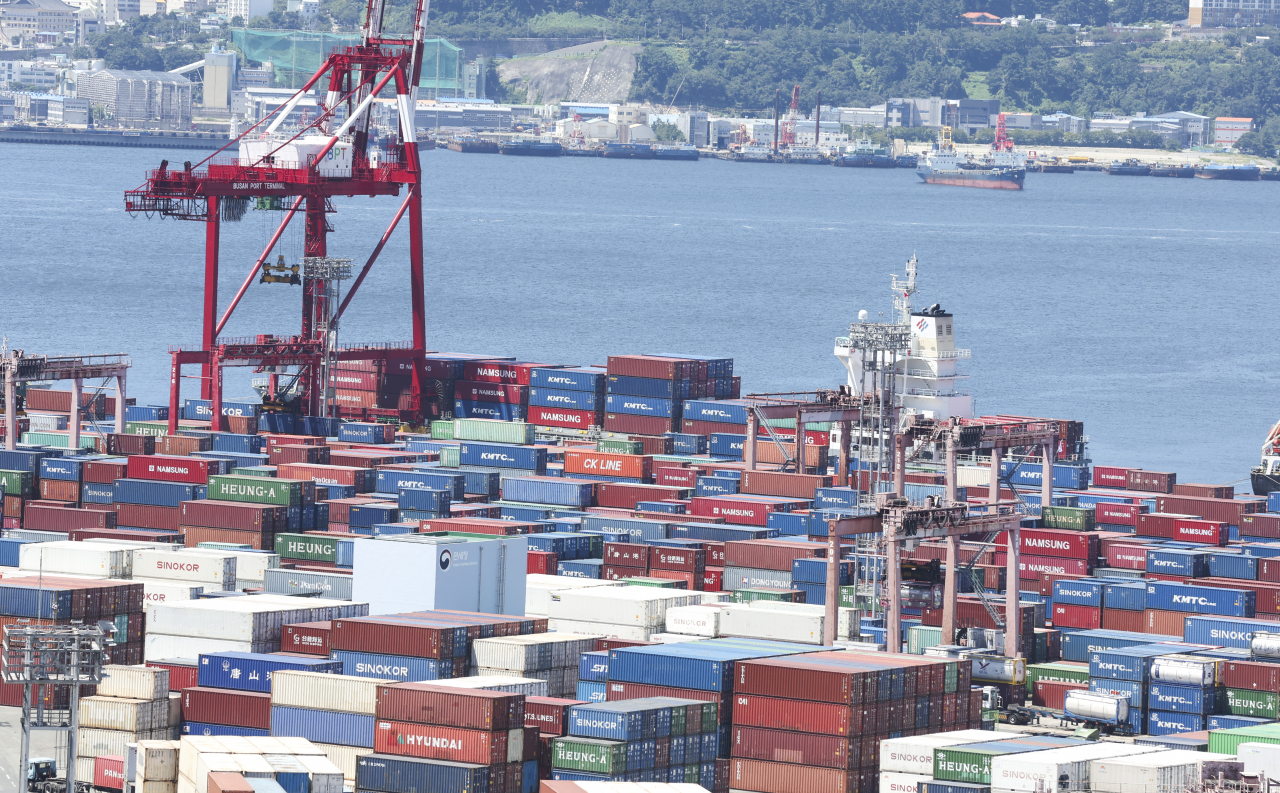 |
Shipping containers are placed at Busan Port, Aug. 1. (Yonhap) |
Global investment banks offered a lukewarm outlook for South Korea’s near-term growth, with their average projection for 2024 remaining at 1.9 percent as of July, according to a report from the Korea Center for International Finance on Monday.
If the Korean economy aligns with these forecasts and achieves 1 percent growth for two consecutive years, it would be the first time since collecting a growth rate statistic in 1954.
The Korean economy's growth rate has fallen below 2 percent on five occasions: in 1956 (0.6 percent), 1980 (minus 1.6 percent), 1998 (minus 5.1 percent), 2009 (0.8 percent), and 2020 (minus 0.7 percent).
“We do not see that foreign investment banks are exhibiting a conservative outlook. With considerations encompassing factors like shifts in the global trade landscape, these results have come out,” said Baek Jin-gyu, an official from the center.
The latest figure came down from previous projections, including 2.1 percent in February and 2 percent in March.
Goldman Sachs (2.6 percent), Barclays (2.3 percent), and Bank of America Merrill Lynch (2.2 percent) were among the institutions that have forecasted a return of Korea’s growth to the 2 percent range next year.
In contrast, other banks including Citi (1.8 percent), JP Morgan (1.8 percent), UBS (1.7 percent), HSBC (1.6 percent) and Nomura (1.5 percent) have anticipated that Korea's growth rate will linger in the 1 percent range in 2024. When calculating the average of these five banks, the anticipated growth rate for Korea is only 1.1 percent.
In 1980, the economy faced a crisis due to a surge in oil prices in 1979. In 1998, during the Asian financial crisis of 1997, in 2009 amid the persisting aftermath of the global financial crisis, and in 2020 when the unprecedented COVID-19 pandemic swept across the world, the Korean economy encountered transient growth shocks.
Investment banks have additionally adjusted their projections concerning Korea's trade surplus.
They have modified forecasts for the average ratio of the current account surplus to gross domestic product, decreasing to 1.6 percent this year from 1.8 percent in 2022, with an expected rebound to 2.4 percent next year.
In June, the estimated current account surplus ratios for this year and the subsequent year were 1.7 percent and 2.5 percent, respectively.
Korea's current account surplus has undergone a substantial contraction, plummeting from $85.2 billion in 2021 to $29.8 billion last year. This year, the current account surplus has tallied up to $2.44 billion as of June, indicating a striking on-year decline of around 90 percent from $24.87 billion.
The dip below a 2 percent average growth rate projection by investment banks for the upcoming year also reflects mounting uncertainty regarding the potential for a second-half rebound in Korea’s economy, a development anticipated to propel the Korean economy towards an upward trajectory.
The Korea Economic Research Institute, a leading private think tank, forecasts that this year's economic growth rate will stall at 1.3 percent, in its third-quarter trend report published on Friday.
"The prospect of China's reopening yielding results (of improving the Korean economy) within this year is highly unlikely,” said KERI official Lee Seung-seok.
“Moreover, if the anticipated effects of China's economic recovery fail to extend to major countries like the US, there is also the potential for Korea's growth rate to further diminish,” Lee added.
Meanwhile, the growth rate forecasts put forth by the Korean government and the Bank of Korea earlier are different from that of some of the investment banks.
While the government unveiled a growth rate projection of 2.4 percent for 2024 early last month, the BOK had previously anticipated a 2.3 percent expansion for the Korean economy in its economic outlook presented in May.
Similarly, the Korea Development Institute, Korea’s state-run think tank, also recently projected a growth rate of 2.3 percent for next year.







![[Today’s K-pop] Blackpink’s Jennie, Lisa invited to Coachella as solo acts](http://res.heraldm.com/phpwas/restmb_idxmake.php?idx=644&simg=/content/image/2024/11/21/20241121050099_0.jpg)